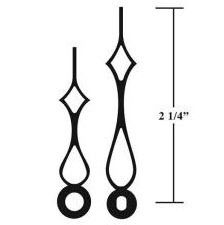
Clock activities are the core cpus within timepieces that calculate moment by moment where all the hands need to be pointing. Clockmakers start with clock motions (also called clock motors) when they are working out their first style, as every little thing else practically hinges upon them. Over the centuries these little mechanical computer systems have actually become innovative tools with the ability of some really jaw-dropping things.
The majority of clock motions report temporal information at differing levels of information as well as according to cycles of different lengths. The cycle could be 12 hrs, 24 hours, a week, or a month. The level of information might be the minute, the second, and even something finer.
But the same mechanism can be adjusted and customized rather to report climate information. Sometimes, (e.g., trend level) a cycle is entailed, whereas in other cases there is simply a direct connection between the output of a sensor (temperature level, moisture) and also the placement on a dial.
Whatever kind of info is reported; it had a lot better be quite precise. If the timing or calibration is not fairly close to the offered requirement, people will certainly quickly find out that the details is unreliable and stop trusting it. Naturally, unless the clock system remains in sync with an atomic standard of some kind, some accumulated error is unavoidable, but there is a nearly universal assumption that a readjustment of more than a few seconds every month or two ought to not be required.
Over the millennia man has actually ended up being fairly accustomed to the rhythms inherent in the everyday daybreak, the stages of the moon, his biological functions, and the periods. Maintaining exact track of all these points is likewise important to him and also has actually been for almost as lengthy. The activity needs to maintain regardless of just what is being tracked, whether related to time or tide.
The old techniques used by clocks for reliably tracking time developed during years. A coiled springtime or hanging weight exerted rotational pressure or an equipment or flywheel. An escapement system affixed to a swinging pendulum withstood outright freewheeling and also regulated the rotational rate.
Pendulums have an all-natural regularity to their swings based primarily on the characteristics of length as well as weight. Modifications to these characteristics allow one to fine-tune the pendulum regularity. With delicate precision, after that, one could adjust the entire system such that it made a single tick for every second.
In more recent times, escapements and also pendulums have been abandoned, and also the quartz crystal has actually taken over as the timing electrical generator for activities. Crystals emit rapid resonances at an unwavering frequency that is much more than a 1-second pace. A set of electronic signs up as well as collectors partitions this initial frequency till the tick/second pulse is derived.
In both the conventional and also contemporary approaches, then, a really precise one-second pulse is derived. From here it is relatively simple to accumulate ticks to ensure that a min is incremented every 60 seconds and so that a hr is incremented every 60 minutes. Electronically this is done with registers; mechanically it is achieved with gear ratios.
Yet these are only the basics. There is practically no limitation to the refinement one can improve this structure. And some impacts absolutely go down jaws.
For example, you don’t have to stick to the typical 12-hour format, with a loads characters or symbols spread around the perimeter of the dial. You could cycle once daily as opposed to two times, resulting in a 24-hour format.
You don’t have to quit there either. You can prolong the cycle into a regular or monthly one, where a fourth hand points at the day of the week or the day of the month, specifically.
In regards to weather condition coverage, the trend level is intermittent, really a mix of both the lunar as well as solar cycles. So the fourth hand of a clock activity might aim at the tide, provided it is adjusted correctly for the phase of the moon and also for regional conditions. This result is quite striking.
Various other weather condition phenomena worth reporting are not intermittent. Instances are the temperature, the humidity, and also the barometric pressure. In these situations, climate movements convert the value result by sensing units right into numbers or positions along calibrated dials.
When the gadget is analog, numerous dials need to be laid over such that they do not interfere with each other, and also the hands have to be mounted on concentric shafts. In the electronic situation, the numerous worths are just shown numerically in different areas. Both formats can being much admired as well as amazing.
One could also utilize accessories to drop jaws. For instance, lots of motors are outfitted to trigger the ringing of chimes on the hour and/or quarter hr. This feature is generally an add-on to whatever collection of attributes currently given by the electric motor.
Another activity accessory is an add-on that oscillates in synchrony with the seconds. One can hook on a pendulum and also convey the impression of something old-fashioned like a grandpa clock. The pendulum can be decorated however one desires making a stylistic statement.
Whether you need something to tell time or to report the weather condition, you will find easily available many clock motions that go down jaws.
